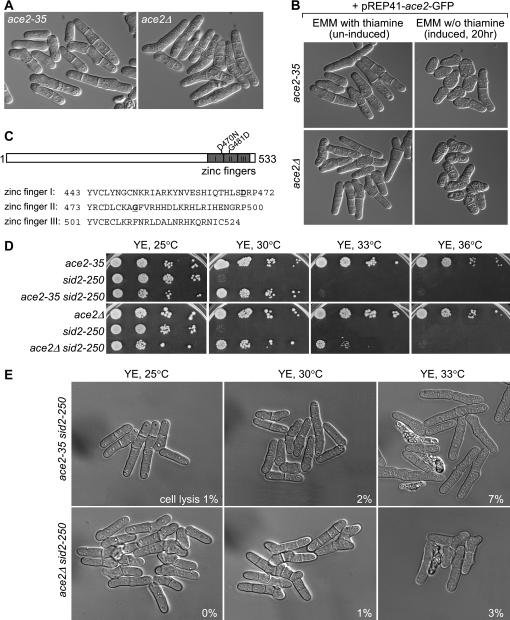Figure 1.
A sid2-250 suppressor, ace2-35, is an allele of the ace2+ transcription factor. (A) The sid2-250 suppressor ace2-35 showed cell-separation defects similar to those of ace2Δ. ace2-35 (YDM1965) and ace2Δ (YDM2028) cells were grown in liquid YE medium and live cells were photographed using DIC microscopy. Quantitatively, 59% and 8% of ace2-35 cells show single septum and multiple septa, respectively, whereas 55% and 36% of ace2Δ cells show single septum and multiple septa, respectively. (B) Ectopic expression of ace2+ from a plasmid could rescue the cell-separation defects in both ace2-35 and ace2Δ cells. ace2-35 (YDM1965) and ace2Δ (YDM2028) cells transformed with plasmid pREP41–ace2–GFP were grown in EMM with thiamine or in the absence of thiamine to induce the expression of ace2+ under the nmt1 promoter. (C, top) Schematic indicating the position of the mutations in the ace2-35 mutant. (C, bottom) Amino acid sequences of three zinc-finger domains at the C terminus of Ace2p. The two amino acids that are mutated in the ace2-35 mutant are in boldface type and underlined. (D) ace2-35 was isolated as a suppressor of sid2-250. A serial dilution growth test was done with strains of ace2-35 (YDM1965), sid2-250 (YDM429), ace2-35 sid2-250 (YDM2025), ace2Δ (YDM2028), and ace2Δ sid2-250 (YDM2027). (E) Suppression of the lysis phenotype of sid2-250 cells by ace2-35 and ace2Δ in liquid cultures grown at low restrictive temperatures. Mutant cells of ace2-35 sid2-250 (YDM2025) and ace2Δ sid2-250 (YDM2027) were first grown in liquid rich medium at 25° to log phase and then shifted to 30° and 33° for 4 hr before images were collected using DIC microscopy. The percentages of lysed cells in each culture are shown.

